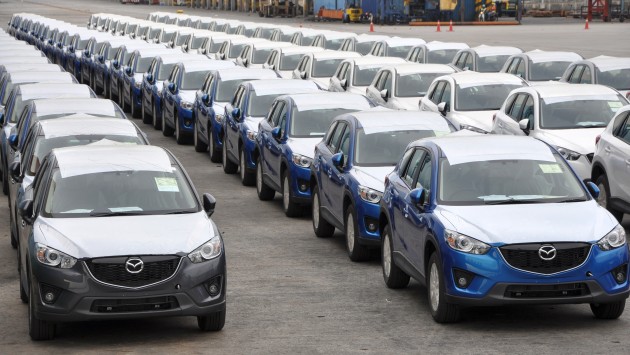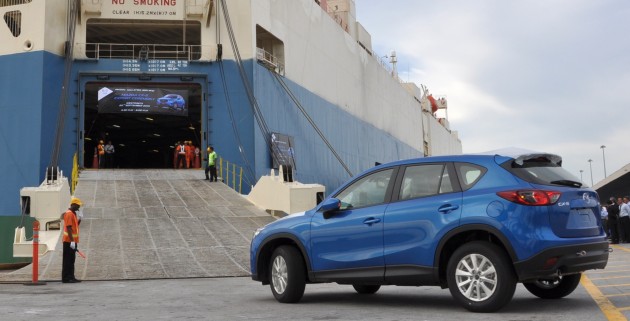Mazda Malaysia has begun exporting the Mazda CX-5 to Thailand – the first shipment of the Malaysian-assembled SUV, which is built at the Inokom plant in Kedah, began last week when some 200 units were loaded on to a RORO in Port Klang to be shipped to the Kingdom.
The CX-5 models being exported include the SkyActiv-G 2.0 litre and 2.5 litre petrol versions as well as the SkyActiv-D 2.2 litre diesel. Reports indicate that a further 400 units of the CX-5 will be shipped to Thailand soon. Thailand is the first country in ASEAN and the region to receive the Malaysian-made units.
While the SkyActiv-D 2.2 variant is assembled locally, the company said that there are no plans to introduce it here, and you can thank the quality of local diesel for that; the Euro-4 compliant oil burner wouldn’t take too kindly to the Euro-2M diesel at the pumps. The 2.5 litre SkyActiv-G version is also not sold locally.
Initially launched here in CBU form in May 2012, local assembly of the SUV began in April this year, with three CKD 2.0 variants entering the market in June. The CX-5 is the second Mazda to be locally assembled at the Inokom facility, after the Mazda 3 sedan and hatchback.
In July 2012, Bermaz Motor, the distributor of Mazda vehicles in Malaysia since 2008, inked a joint venture agreement with Mazda Motor Corporation for a manufacturing programme in Malaysia, with an eye on increasing local assembly and manufacturing activities in the country.
Mazda’s entry saw the establishment of Mazda Malaysia, which is responsible for both manufacturing and increasing localisation activities to support Bermaz Motor’s sales and marketing efforts. Mazda has a 70% share in the JV, with the rest held by Bermaz.
Looking to sell your car? Sell it with Carro.





























AI-generated Summary ✨
Comments express pride over Mazda’s export of the CX-5 from Malaysia to Thailand, highlighting the significance of exports for national economic stability and criticising local importers or grey market sellers. Many mention the delay and backlog in delivery due to production constraints and express a desire for more engine options, including diesel and petrol variants. There is frustration over the limited availability of Euro 4/5 diesel fuel locally, with some blaming high costs or government policies, and skepticism about why cleaner diesel isn't available at affordable prices. Several comments reflect disappointment about Malaysia’s limited diesel infrastructure and emission standards compared to neighboring countries, and some observe that other markets benefit from modern diesel options while Malaysian consumers are left behind.